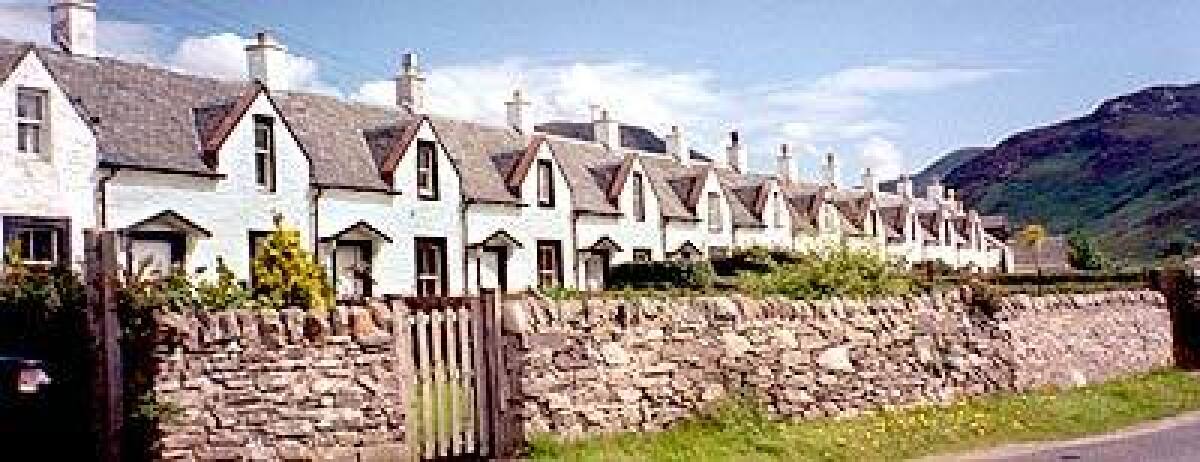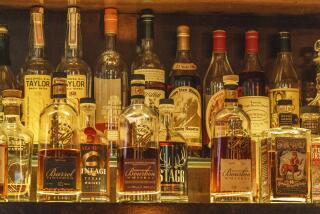The true spirit of the islands

Leaning into a huge wooden fermentation tank, I inhaled the yeasty aroma of its contents. “Don’t sniff too heavily,” Ardbeg Distillery Manager Stuart Thomson told me. “It’ll take your breath away.”
High levels of carbon dioxide can kill, he said, adding, “If you fell in, you’d be dead in 12 seconds.”
Ardbeg is on Islay (eye-la), southernmost of the Inner Hebrides, off western Scotland. For devotees of single-malt whiskey — people who utter brand names such as Laphroaig reverently — Islay and neighboring islands Jura and Arran are paradise found. Among them, they have nine distilleries, one of Scotland’s major concentrations. These single-malt labels are not as familiar to most Americans as those of blended Scotches, but their whiskies go into such blends as Johnnie Walker, Teacher’s, Cutty Sark, Cluny and Ballantine’s.
Although the more intensely flavored single malts are made only from malted barley, the blends are made from barley, malted barley and other cereals.
In mid-July, I bypassed the more frequently visited mainland whiskey trails of Scotland and distillery-hopped on the three islands. Each, I found, had its own personality. Arran, with its miles of rugged coastline and lush interiors, is the prettiest and the most visitor-oriented. Islay is flatter, has acres of peat and is synonymous with its seven distilleries. Jura is rural and sparsely populated.
My trip began in Glasgow, where I picked up a rental car and drove two hours west to Ardrossan to catch the Caledonian MacBrayne car ferry for the short crossing to Arran. The ferry is pricey, but I saved about $85 by buying a “hopscotch ticket” to Arran, the Kintyre Peninsula, Islay and back for about $358.
Near Lochranza on Arran’s coast, I visited Scotland’s newest distillery, Isle of Arran. It opened in 1995, 160 years after Arran’s last distillery fell victim to high taxes and poor transportation.
Older island distilleries sit seaside — as was vital when all cargo was carried by ship — but Isle of Arran occupies a bucolic site in the shadow of the Hill of the Eagle’s Nest.
Visitors have included Queen Elizabeth II, who dropped by in 1997 on the last voyage of the royal yacht Britannia. The inviting visitor center has a restaurant serving such specialties as cullen skink (smoked haddock and potato soup) and chicken breast stuffed with haggis — yes, haggis — mousse.
I passed on the mousse and had some soup before joining a tour led by Terry, a jolly fellow in plaid pants. He immediately clarified one of his distillery’s claims to fame: Isle of Arran is the island’s first legal distillery in 160 years; illegal stills thrived for years.
The tour was my introduction to the language of whiskey-making. I heard, as I would often in the next few days, that good water makes good whiskey. Isle of Arran’s water comes pure from a stream in nearby hills.
Terry poured samples and cautioned visitors, “Wee sips; no big gulps.” He needn’t have said it to me. Dead sober, I was terrified of Arran’s narrow, twisting roads where locals drive less on the left than smack in the middle.
At tour’s end, I caught up with white-haired, rosy-cheeked Gordon Mitchell, whose baseball cap identified him as the Arran malt master. He has been a whiskey maker for 40 of his 60-plus years, “starting with cleaning the floor and working my way up.”
By now, he says, he can tell a good whiskey by sniffing, a talent known as “nosing.”
“A bad one might smell like sweaty socks,” he said.
Although he takes his whiskey “neat, with a little water after”— and only on weekends, mind you — he didn’t recoil at my mention of ice, but was emphatic about soda, as in “no soda.” Other whiskey makers would tell me that while they may consider ice or soda a travesty, they’re not fuddy-duddies about it.
Soon, I was off by ferry from Lochranza to the Kintyre Peninsula for an overnight before catching another ferry to Islay (population 3,300). Map in hand, I set out from Bowmore, the island capital, toward Port Askaig, soon spotting the turnoff to Caol Ila (cul-lil-a). After a white-knuckle mile on a “single track” road — a narrow, twisting single-lane with two-way traffic — I spotted the distillery at shore’s edge.
It was “silent season” at Caol Ila — the six weeks when the plant shuts down for maintenance — but Neil Ferguson, an Islay native (or Ileach, as the people of Islay call themselves) was happy to show me around.
“I learned whiskey-making the old way,” said Ferguson, who has worked at the distillery for 35 years. A still house had floor-to-ceiling windows affording a stunning view of the sound; in front of them stood six onion-shaped copper stills, almost two stories high. That still shape affects a whiskey’s taste, Ferguson told me. “All the single malts are unique,” he said. “The recipe may be similar, but everybody has their way of going about it.”
Like all island distilleries, this one is low-tech. Humans control things, just as they did when the distillery opened in 1846. Computers? “It’ll be a sad day,” Ferguson said, frowning.
Next, I met Bowmore Distillery Manager Ian McPherson, who took me to the malting barn, where he used a wooden shovel to toss barley into the air, the old-fashioned way. Making good whiskey, he said, is “all in the wee things.”
McPherson worked 34 of his 59 years at Bowmore, Islay’s oldest distillery, founded in 1779. He has weathered the ups and downs of the whiskey business, watching distilleries close, reopen and change hands. He shrugged. “Drinkers are fickle,” he said. “They go into wine, beer, those stupid, funny-colored drinks.”
Today, single malts are selling well, but “we’re trying to turn you around,” he said of Americans, who usually prefer blends.
He tossed chunks of Islay peat into the ancient kiln. Smoke stung my nostrils. He opened a mash tun — a big metal vessel — and let me peer at the frothy mix of water and grist that would become wort, a sweet-tasting sugary liquor. He explained that the “draff,” what’s left after the sweet liquor is drained off, would be fed to cattle. “We know the masher hasn’t done his job if the cows get drunk,” he said.
‘Like a cathedral’
The next morning, I drove back to the Sound of Islay and Bunnahabhain (boon-a-haven) Distillery, following road markers made from barrel lids. Production Manager John MacLellan proudly showed off a mash tun — “the biggest one on the island.” I noticed that the brass and glass spirit safe, through which spirit flows from the stills, was padlocked. The tax collectors “keep a very close check” on the alcohol volume, he said. “At day’s end, it should all add up.”Barrels of aging whiskey were stacked in the century-old warehouse. “People walk in here and say it’s like a cathedral,” MacLellan said. “It’s a pilgrimage.”
When I mentioned that single malt was an acquired taste for Americans, he nodded. “They like light in color,” he said. “Funny people, Americans.”
Next I boarded a five-car ferry for a five-minute crossing to the small island of Jura. After six miles on a single track shared with trucks and sheep, I reached the harbor village of Craighouse, where Isle of Jura distillery Manager Michael Heads met me.
Soon, he was relating the history of the 194-year-old distillery. All was well until 1900, when a landlord raised the rent, forcing the owner to shut down. The distillery eventually reopened after new owners took over.
Heads showed me his four copper stills, each more than 25 feet high, explaining that height produces a sweeter spirit through a process called reflux, wherein alcoholic vapors rise to the neck and fall back to be redistilled. “This is where you can alter the character of the spirit,” he said, as I tried to avoid looking down at the dizzying metal grate floor.
The distillery is the island’s major employer, he said: Its 12 employees constitute “30% of the working population of the island.” Jura’s solitude lured author George Orwell, who lived here in the 1940s while writing “1984.”
Returning to Islay, I headed to Ardbeg, home to three distilleries, for a tour of Laphroaig (la-froyg). We immediately saw photos of a kilted Prince Charles on a 1994 visit, remembered by some islanders because his plane ran off the runway at Islay’s airport.
Laphroaig’s white farmhouse-style buildings are a reminder that whiskey once was a farm byproduct, distilled from surplus barley. Our perky guide, Debbie MacDougall, 22, told us that the peat fire in the kiln was topped off every 20 to 30 minutes “to keep it as smoky as possible” and that it consumed 1 1/2 tons of peat every 12 hours.
MacDougall introduced us to the phrase “angels’ share,” which is the 2% of whiskey lost each year from aging casks through evaporation. “They’re very happy angels,” she mentioned. So were we, as she poured wee drams.
On the radar
On my last day on Islay, I drove to Bruichladdich (brook laddy) Distillery near the whitewashed village of Port Charlotte, braking for black-faced sheep and a friendly cow that poked its head into my car window. Bruichladdich calls itself the WMD — Whiskey of Mass Distinction — since being “monitored” last year by a U.S. Department of Defense agency after the distillery installed 14 Web cams to enable its devotees to watch whiskey-making on their home computers.My guide, Isabel Coughlin, suggested that suspicions were raised when the company bought parts from a defunct mainland distillery and had them shipped over by barge. But a spokeswoman for the Virginia-based Defense Threat Reduction Agency said monitoring foreign commercial facilities was “not part of [its] mission.”
“A low-level DTRA employee used agency e-mail to access the Bruichladdich distillery Web cam,” she added.
Coughlin said, “We’re known in the industry as a bit of a wee laddy.” Interpretation: Bruichladdich enjoys making waves. Unlike other Islay distilleries, it has no corporate parent but is owned by 40 investors, including 12 Americans, who bought it in 1994.
Almost reverently, Coughlin ran her fingers over the “jolly noisy” belt-driven wooden malt mill that dates to 1881. She poured grist into my palm, explaining that the mix must be just right. “If you get too much flour, it’s going to go goopy like glue,” she said. “If you get too much husk, you’re not going to get enough sugar for fermentation.”
Time ran out before I could get to Lagavulin Distillery, so my last stop was at Ardbeg Distillery in Ardbeg. With its Old Kiln Café and shop, it is very visitor-friendly. Manager Stuart Thomson walked me through a centuries-old wooden malt storage building and showed me the 123-year-old mill, the oldest working mill of its type in the world.
Thomson described Ardbeg, the most heavily peated of Islay’s malt whiskies, as “the buzz malt.” In 1997, he said, “We were selling 20 cases of 12” annually in the United States. “Now, you’re talking about 2,200 cases.”
We talked about the hands-on, computerless traditions of the island’s distilleries. “Mystique is great in Scotland,” Thomson said. “We give you the Loch Ness monster, things like that.”
Once home, that mystique mingled in my memory with the aroma of smoking peat, the yeasty tang of fermenting barley and the hospitality of the Ileachs.
*
(BEGIN TEXT OF INFOBOX)
Whiskey trail
GETTING THERE:
From LAX, Continental has direct flights (stop but no change of plane) to Glasgow, Scotland; connecting service (change of plane) is available on American, Air Canada, US Airways, KLM, Aer Lingus, Continental and British Airways. Restricted round-trip fares begin at $646.
From mainland Scotland to the islands, Caledonian MacBrayne operates frequent car/passenger ferries. Reservations required. 011-44-870-565-0000, https://www.calmac.co.uk .
TELEPHONES
To call the numbers below, dial 011 (international code), 44 (country code for Scotland) and the local numbers.
WHERE TO STAY:
Harbour Inn, The Square, Bowmore, Scotland; 149-681-0330, https://www.harbour-inn.com . Doubles with full breakfast start at $175.
Port Charlotte Hotel, Main Street, Port Charlotte, Scotland; 149-685-0360, https://www.portcharlottehotel.co.uk . Pretty, antiques-filled guest rooms in family-friendly inn fronting on sandy beach. Doubles with full breakfast, about $190.
WHERE TO EAT:
Harbour Inn, Bowmore (see above), serves excellent meals in a pretty blue and white room overlooking Loch Indaal. Reservations recommended. Dinner entrees, $27-$41.
Lochside Hotel, Shore Street, Bowmore; 149-681-0244, https://www.lochsidehotel.co.uk . Food is OK in this lively bar or in the waterfront dining room. Dinner entrees from about $10.
DISTILLERY TOURS:
Scotland’s distillers welcome visitors. Phone ahead, because some have regularly scheduled tours and some have tours by appointment. Here are numbers and websites:
Isle of Arran, 17-70-830-334, https://www.arranwhisky.com .
Isle of Jura, 14-96-820-240, https://www.isleofjura.com .
Ardbeg, 14-96-302-244, https://www.ardbeg.com .
Bowmore, 14-96-810-671, https://www.bowmore.com .
Bruichladdich, 14-96-850-221, https://www.bruichladdich.com .
Bunnahabhain, 14-96-840-646, https://www.burnstewartdistillers.com .
Caol Ila, 14-96-302-760, https://www.discovering-distilleries.com .
Lagavulin, 14-96-302-400, https://www.malts.com .
Laphroaig, 14-96-302-418, https://www.laphroaig.com .
TO LEARN MORE:
Scotland National Tourism Board, 23 Ravelston Terrace, Edinburgh, EH4 3TP; 131-332-2433, www .visitscotland.com.
More to Read
Sign up for The Wild
We’ll help you find the best places to hike, bike and run, as well as the perfect silent spots for meditation and yoga.
You may occasionally receive promotional content from the Los Angeles Times.






